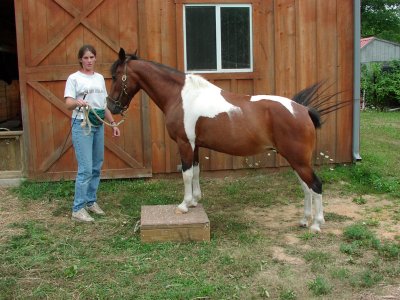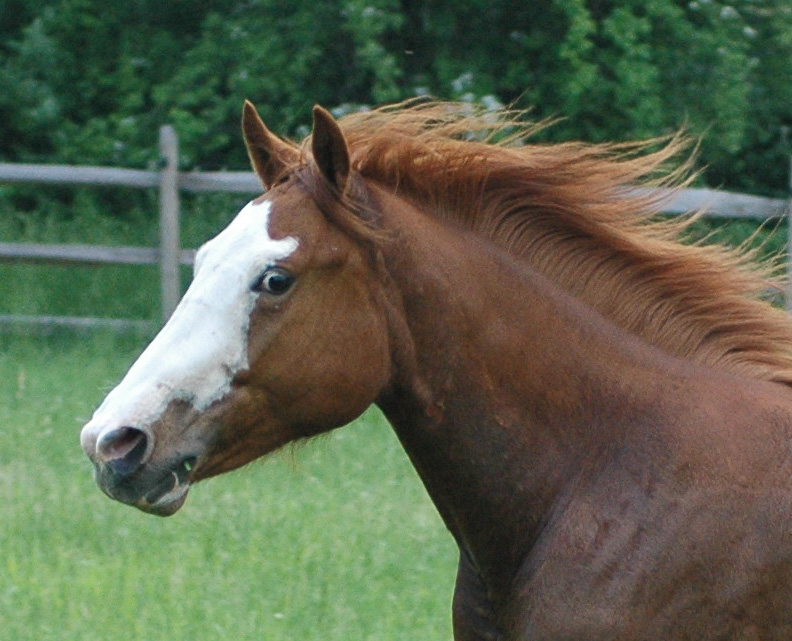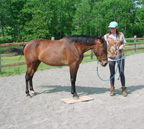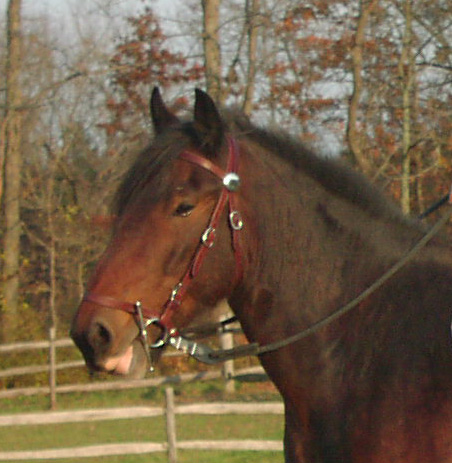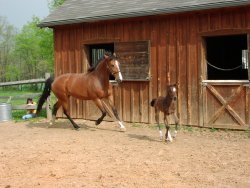il.com
Clicker Stages & Getting
Stuck
Elaine Elmer
When I hear people talk about a horse getting stuck
with Clicker Training and not really making progress beyond a certain point,
I think there are a lot of dependences.
First, having started a range of horses from sucklings (clean slates)
to rehabs (carrying around maximum baggage), I have found in the case of
young horses, there can be a maturity issue because babies tend to think
they should always get what they want instantly.
But there is also a buy-in issue, and that occurs with all horses at
any age. Clicker training is
like any training method in that until the horse has accepted the idea of a
task, it doesn't pay off to move on beyond the most fundamental stuff.
For example, you would probably never consider trying to ride a jumping
course or a dressage test or run a barrel pattern on a horse that had not
accepted a rider on his back. I
think this is a variation of the same theme.
Perhaps because the consequences are less obvious, Clicker Trainers
often do try to rush through some of the stages of Clicker Training.
There are a number of stages that a horse may go through with c/t, and how
fast a horse goes through these stages will depend upon the horse (age,
history, baggage, eagerness, attention span) and the trainer (age, history,
baggage, eagerness, attention span).
1. All You Can Eat Food Bar Stage:
The horse thinks the trainer is a walking food bar. The horse can be
greedy and can be pushy. He only sees what this food bar can do for
him.
2. Trigger Stage: The
horse makes a connection between the bridge sound and the food. It
might be easy for some folks to think that this stage means the horse has
figured out what this training is all about, but I don't think so (yet).
Mugging can be just as obnoxious if it isn't stopped, but he is coming to
see there is a sequence. At this point, they may appear to get it, but
the horse tends to be inconsistent and easily frustrated.
3. Light bulb Stage: The
horse makes a connection between a behavior causing the bridge (click),
which triggers the food vendor to vend. If the horse is emotionally
immature and hasn't bought into the 'process', they may appear to have
'gotten it' but in reality, some personalities may be easily frustrated
because they are struggling with: do they want the treat enough to do <fill
in the blank>. They are coming to see this is their choice and
that alone can be a new and unusual state for certain horses. At
this point, some prior understanding of training will help progress the
horse to the next stage. A trainer can *prevent* a horse from moving
on to the next stage by increasing pressure instead of waiting for the horse
to choose the correct response at this stage because the horse learns that
if he doesn't do it, he will be pressured. In the worst case, the
treat can become a bribe instead of a reward. This is a trainer issue,
not a c/t issue. The only way to progress a horse thru this stage is
to keep on keepin’ on with consistent training behavior so that the horse
can 'buy in'.
4. Buy-In Stage: The horse
develops an understanding of “learning” (not just a behavior causes the
click but a particular behavior causes a click. He has developed some
level of trust in the trainer - that the trainer will not ask for anything
too unreasonable, even if things appear scary. I think this stage is
where many repetitions often occur in order to refine a behavior.
And at this state, the horse is beginning to see that there is an end
to the means, in his own way.
5.
Eureka
Stage: The horse and trainer develop a dialog of learning where chains
of behavior can be built without extensive repetitions because a dialog has
been established between the horse and trainer. At this stage, the
horse has finally learned to learn and in this last phase, the actual food
motivator can become less
important than the dialog and the game. Some people may not make a
distinction between Buy-In and
Eureka.
I think horses get stuck in stages just like humans can get stuck.
I suspect many horses stall out at the point that they have made a
connection, but hasn't bought into the concept of learning yet. The
treat is supposed to be the
motivator and it works because food IS such a strong motivator. But it
can also dredge up some less than pleasant attributes in a horse's
personality if he is under the impression that he should get the treat
without earning it in any way or being confused and not being able to clear
up his confusion. I think this is where the anger displays come from -
being in this stage and not moving beyond.
So, there are two ways to move beyond being stuck, keep going with c/t,
diligently until the horse progresses into the 4th phase (which is what all
Clicker Trainers are likely to recommend) OR drop c/t and go to other
methods where the horse is less motivated and less prone to acting out.
Both can work, it depends upon the trainer’s ability and desire to
work past any obnoxious phase and the options available. For example, if the
horse has been a training drop out from all other imaginable methods, there
may be few options but to forge ahead.
I think the reason that some horses can return to c/t
later after they have a knowledge base is because at that point, a good
trainer has established a foundation of communication so that there is some
common training language.
This means that the horse progresses thru to step 4 faster, possibly in
minutes instead of days.
Of course, training mistakes can and do happen, but those mistakes are less
critical once the horse has reached a state of confidence. And this
confidence isn't really fully installed until stages 4-5. Prior to that
point, the horse tends to be more volatile because he is insecure and easily
confused. Add some immaturity to the equation and things can
escalate.
The added difficulty when applying C/T to an immature horse (physically or
mentally) is young horses are like most young things, they can be very self
centered and enthusiastic. Lots
of enthusiasm is a good thing, as long as the trainer can direct it
comfortably. Young horses
function as if they have a mantra: MeMeMeMeMeMe. They have to learn
that life is give and take, not just take. For some personalities
(horses and trainers), more conventional methods are more comfortable
because the trainer may not feel he/she has the tools to redirect the
enthusiasm and self-centeredness to a more partnership based relationship.
I've seen these stages in all
ages, sizes, breeds (that I have worked with) and emotional states that I've
encountered. I’ve always seen a consistent pattern in each horse I’ve
worked with. What hasn't been consistent is the amount of time it takes to
move through each phase. C/T is pretty much a one-size-fits-all
training plan, but each horse and trainer will encounter different hurdles
as they go and progress through the different stages at their own pace.
Home |
Articles |
Clicker Basics |
Community |
FAQ |
Getting Started |
Horse Stories |
Links |
Photos |
Resources
 |
Equine Clicker Training |
 |


